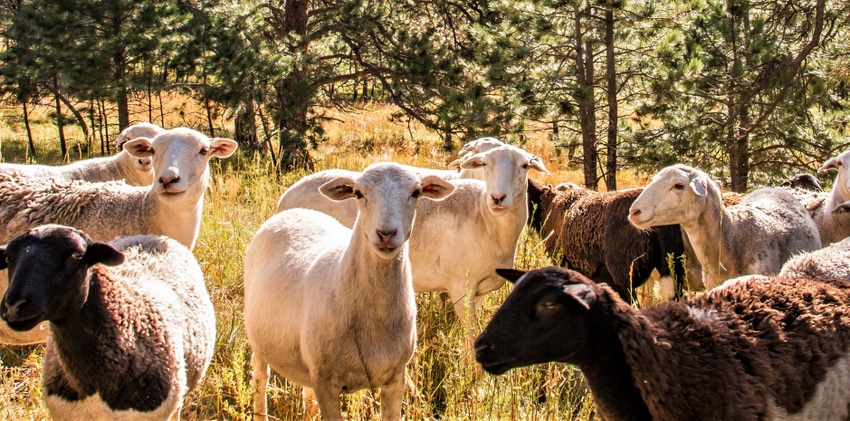November 2, 2021

Livestock grazing serves several purposes. It feeds the livestock, regenerates plant and soil health, and—when animals are grazed in orchards or woodlands—lessens wildfire severity by reducing fuel loads.
Agroforestry is an umbrella for several ag practices that integrate trees into crop and livestock systems for the holistic benefits to the environment, farm economy, and society. Silvopasture specifically refers to land that is intensively managed for the overstory, the trees, the forage and the livestock to produce both tree and animal products.
For woodlands to be maintained for a healthy timber harvest, they must be managed for pest infestations, soils and hydrology.
“A challenge for woodland managers,” says Mark Batcheler, a Washington State University PhD candidate researching agroforestry in the Pacific Northwest, “is that forests need an ecological disturbance for maximum health. Here in eastern Washington, that naturally occurs through wildfire, windfall and disease. Managers must mimic the ecological processes. Controlled burns are the most similar to a natural process, but hold the greatest risk to human populations. Another alternative is to masticate with machinery to grind up downed trees, grasses and shrubs.”
A holistic way to provide the ecological disturbance a forest needs for ultimate health, and add a revenue source, is to graze livestock in high densities for short time periods.
Batcheler studies how silvopasture managed grazing compares to unmanaged grazing of forested areas, ungrazed woodlands, and grazed pastures with no trees.
“This past summer was very hot and dry across the West,” he says. “I, along with others, observed that the grass finished and dried up quicker than normal. This happened whether there were trees present or not. However, we noticed that grasses shaded by trees stayed greener longer despite severe drought conditions. The forage quality lasted longer and it produced higher yield under the trees.”
The silvopasture provided increased quality and quantity of forage in July through September, which is the driest period of the year in eastern Washington.
Shelter for livestock
Trees provide heat shelter to the livestock, too. “You’ve seen it,” Batcheler says, “if there’s a single tree in a pasture the whole herd is shaded up under it on a hot day. That has a negative impact. The soil is compacted, all the forage gone, and the bare soil contributes to erosion and invasive plant species.”
In silvopasture, which contains multiple trees, the livestock spread out more. This avoids detrimental impact to a single tree and area. By grazing in the shade, the animals’ body temperature remains lower. They gain weight faster and maintain body condition, because they aren’t heat stressed.
Silvopasture practices can also benefit orchard trees, such as nuts and fruits, as well as vineyards. “Because orchards and vineyards produce human food crops,” Batcheler says, “food safety must be kept in mind to keep animal feces away from the food products. There’s huge potential to integrate more livestock grazing into them, though, because the vegetation between the rows must be managed.”
Several vineyards employ sheep and ducks to graze vegetation, and, in case of the ducks, control pest populations. “Ducks have been used in vineyards for hundreds of years in France,” Batcheler says. “Most people think of ducks as something that lives on your pond, but duck is really good meat. There’s a high-value niche market for both duck meat and duck eggs.
“The beauty of agroforestry is the ability to stack ecological functions and economic revenue sources for holistic management. Instead of a monoculture — whether timber, pears, grapes, cattle or ducks — under agroforestry management some can be combined for mutual environmental service. For instance, there’s sheep grazing in the orchard. The sheep keep the vegetation down for easy harvesting and healthier trees, and enrich the nutrient cycle. The orchard trees shelter the sheep and the forage between rows feeds the sheep.”
As wildfires burn the Western states, agroforestry combined with targeted grazing can be utilized to use livestock to reduce fire fuel loads.
“Wildfires do happen and will happen,” Batcheler says. “When a fire reaches an area where the understory has been managed through livestock grazing, it is likely that this will reduce fire severity.” That is one ecosystem service that livestock, grazed with silvopasture methods, can provide.
Additionally, there is carbon sequestration, maintaining wildlife habitat, regenerating soil health, and protecting waterways from erosion and turbidity. Agroforestry practices become more important as the climate fluctuates and summers are hotter. Grazing livestock on silvopastures provides more adaptability and resiliency for producers, both environmentally and economically.
About the Author(s)
You May Also Like




